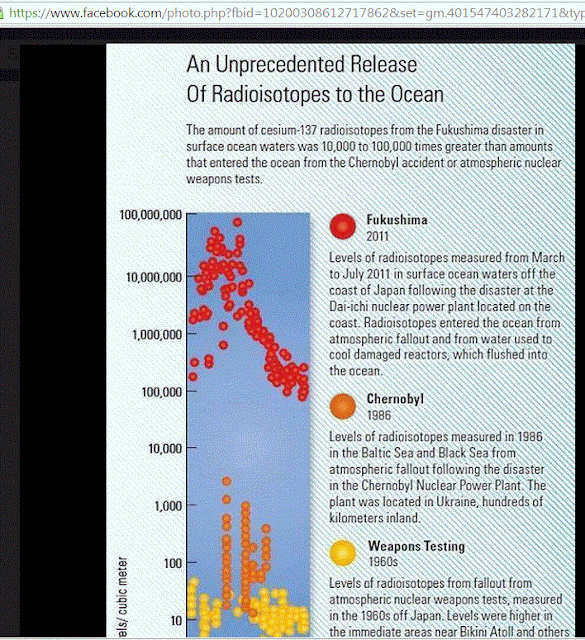Sep 17, 2013
"EnviroReporter took a road trip to the Central Coast of California that included visiting a fisherman and his wife, Will and Robin, at their beautiful Santa Barbara home to test an assortment of fish and sea creatures for radiation. Will offered us an excellent opportunity to test yellowtail, bluefin tuna, rockfish, bluefin tuna "collar," mussels, squid, albacore tuna and yellowtail collar. All the fish was caught locally by Will and measured at background. This is probably because the Sea of Fuku Goo hasn't made it down to Southern California yet. The results, while hopeful for the time being, do not change EnviroReporter's admonition not to eat or consume anything from the Pacific unless you can verify yourself it is radiation-free. That includes seaweed and its derivative carrageenan which is widely used in the food industry and toothpaste for its gelling, thickening and stabilizing properties. But at least for the time being, these anecdotal tests show that at least some of Southern California's fish are still not hot."
Source; description under video
It would have been nice to do timed 10 minute tests on each of these fish samples, rather than what he did in this video, but if there is radiation in the fish it is more than likely at a low level.
If the background radiation is 50, a 15% error on the high side would be a high reading of 57, but several of the fish came in at 70, which to us means there may be something there. Not that much, but something. The difference between 57 and 70 is 13.. Of course there is no way to know for sure, unless you do a timed test both on the background radiation and on the food sample. This is the ONLY way to figure out radiation levels in food that are less than screaming hot.
Now if we assume the 13 counts per minute indicates that there is some radiation in at least one of these fish samples, how would we find out what that means more specifically? It would mean taking this fish to a location where more sophisticated radiation testing equipment is available, such as a lead lined container and a device that can 'read' individual isotopes, as well as the radiation measurement in bq/kg specifically. Ideally, your local grocery store will have one of these installed soon, thanks to you suggesting it to them, right?
Geiger counters are NOT designed to detect radiation in food, bottom line. Here we have evidence of why it is so hard to use a radiation detector in that way, unless the food item is screaming hot..
At best, a pancake detector is a first, very rough, screening tool to figure out if something is screaming hot or not.. Anything more, and one needs a much more precise and sensitive radiation testing machine. Especially with kids, it pays to keep the food as clean as possible, with radiation levels below 5 bq/kg. A geiger counter cannot tell you about foods with this low of a radiation level.
That is why a two prong radiation detection strategy is important. First, work with a local group or community group and convince a local grocery store or other public facility to install an official $15,000 food radiation detecting machine.
Then buy a pancake style radiation detector to protect the kids and family everywhere else. Between those two things, that is about as much as you can do in the way of detecting dangerous levels of radiation. Why is this strategy so important for families to implement?
Reports: “Highly significant quantity” of fission products being flushed into environment by water used on Fukushima molten fuel, including plutonium and curium — Radioactivity to recirculate for many generations in food chain, meat content will increase with time
Fukushima is releasing a Niagara Falls of radiation into the Pacific, starting on 3/11 and continuing until now.
Our estimation is that the main, concentrated high radiation plume from Fukushima will eventually get to the US coast, sometime between now and 2016. The airborne radiation already swept over and caused a 98% dead creatures and plankton covering the ocean bottom in 2011. The combination of this one, two punch of radiation will have a major impact on the ocean and all life in it, over time.
If you and your community get ready now, you will be in the best position possible when the S(#*# hits the fan sometime down the road. Of course, if nothing happens, so much the better, but as the wise man says; it is better to be prepared and prevent, rather than to react with panic after something happens, due to lack of preparation.
END
Testing Many Types Of Pacific Ocean Fish With Inspector Radiation Detector on Sept. 17th, 2013; via @AGreenRoad
http://agreenroad.blogspot.com/2013/12/testing-many-types-of-pacific-ocean.html


Post a Comment